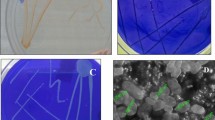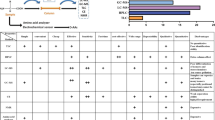Abstract
Guanosine 5′-diphosphate-3′-diphosphate (ppGpp) is a small molecule nucleotide alarmone that can accumulate under the amino acid starvation state and trigger the stringent response. This study reported the extraction of ppGpp from the Gram-positive bacteria Clavibacter michiganensis through methods using formic acid, lysozyme, or methanol. Following extraction, ppGpp was detected through ultra-high-performance liquid chromatography (UHPLC) and liquid chromatography-tandem mass spectrometry (LC-MS/MS). The methanol method showed the highest extraction efficiency for ppGpp among the three methods tested. C. michiganensis cells in exponential growth phase was induced in amino acid starvation by serine hydroxamate (SHX) and used for ppGpp extraction and detection. When using the methanol extraction method, the results showed that ppGpp concentrations in SHX-treated samples were 15.645 nM, 17.656 nM, 20.372 nM, and 19.280 nM at 0 min, 15 min, 30 min and 1 h, respectively, when detected using LC-MS/MS. This is the first report on ppGpp extraction and detection in Clavibacter providing a new idea and approach for nucleotide detection and extraction in bacteria.





Similar content being viewed by others
Data availability
The raw data is without undue reservation. The data and material can be available from the authors.
References
Cashel M, Gallant J (1969) Two compounds implicated in the function of the RC gene of Escherichia coli. Nature 221:838–841
Lu WJ, Wang JW, Xu J (2012) Alarmone ppGpp and its role in the environmental adaptations of microorganisms. Chin Bull Life Sci 24(4):385–389. https://doi.org/10.1016/j.mib.2015.01.012
Potrykus K, Cashel M (2008) (p)ppGpp: still magical? Annu Rev Microbiol 62:35–51. https://doi.org/10.1146/annurev.micro.62.081307.162903
Gupta KR, Baloni P, Indi SS, Chatterji D (2016) Regulation of growth, cell shape, cell division and gene expression by second messengers (p)ppGpp and cyclic di-GMP in Mycobacterium smegmatis. J Bacteriol 198:1414–1422. https://doi.org/10.1128/JB.00126-16
Hallez R, Delaby M, Sanselicio S, Viollier PH (2017) Hit the right spots: cell cycle control by phosphorylated guanosines in Alphaproteobacteria. Nat Rev Microbiol 15(3):137–148. https://doi.org/10.1038/nrmicro.2016.183
Liu K, Bittner AN, Wang JD (2015) Diversity in (p)ppGpp metabolism and effectors. Curr Opin Microbiol 24:72–79. https://doi.org/10.1016/j.mib.2015.01.012
Magnusson LU, Farewell A, Nystrom T (2005) ppGpp: a global regulator in Escherichia coli. Trends Microbiol 13(5):236–242. https://doi.org/10.1016/j.tim.2005.03.008
Ross W, Vrentas Catherine E, Sanchez-Vazquez P, Gaal T, Gourse Richard L (2013) The magic spot: a ppGpp binding site on E. coli RNA polymerase responsible for regulation of transcription initiation. Mol Cell 50(3):420–429. https://doi.org/10.1016/j.molcel.2013.03.021
Srivatsan A, Wang JD (2008) Control of bacterial transcription, translation and replication by (p)ppGpp. Curr Opin Microbiol 11(2):100–105. https://doi.org/10.1016/j.mib.2008.02.001
Atkinson GC, Tenson T, Hauryliuk V (2011) The RelA/SpoT homolog (RSH) superfamily: distribution and functional evolution of ppGpp synthetases and hydrolases across the tree of life. PLoS One 6(8):e23479. https://doi.org/10.1371/journal.pone.0023479
Xiao H, Kalman M, Ikehara K, Zemel S, Glaser G, Cashel M (1991) Residual guanosine 3′,5′-bispyrophosphate synthetic activity of relA null mutants can be eliminated by spoT null mutations. J Biol Chem 266:5980–5990
Hamel E, Cashel M (1973) Role of guanine nucleotides in protein synthesis. Elongation factor G and guanosine 5′-triphosphate, 3′-diphosphate. Proc Natl Acad Sci U S A 70:3250–3254. https://doi.org/10.1073/pnas.70.11.3250
Hauryliuk V, Atkinson GC, Murakami KS, Tenson T, Gerdes K (2015) Recent functional insights into the role of (p)ppGpp in bacterial physiology. Nat Rev Microbiol 13(5):298–309. https://doi.org/10.1038/nrmicro3448
Mechold U, Potrykus K, Murphy H, Murakami KS, Cashel M (2013) Differential regulation by ppGpp versus pppGpp in Escherichia coli. Nucleic Acids Res 41(12):6175–6189. https://doi.org/10.1093/nar/gkt302
Nanamiya H, Kasai K, Nozawa A, Yun C-S, Narisawa T, Murakami K, Natori Y, Kawamura F, Tozawa Y (2007) Identification and functional analysis of novel (p)ppGpp synthetase genes in Bacillus subtilis. Mol Microbiol 67(2):291–304. https://doi.org/10.1111/j.1365-2958.2007.06018.x
Ochi K (1986) Occurrence of the stringent response in Streptomyces sp. and its significance for the initiation of morphological and physiological differentiation. J Gen Microbiol 132:2621–2631. https://doi.org/10.1099/00221287-132-9-2621
Ochi K, Kandala JC, Freese E (1981) Initiation of Bacillus subtilis sporulation by the stringent response to partial amino acid deprivation. J Biol Chem 256:6866–6875
Washio K, Lim SP, Roongsawang N, Morikawa M (2010) Identification and characterization of the genes responsible for the production of the cyclic lipopeptide arthrofactin by Pseudomonas sp. MIS38. Biosci Biotechnol Biochem 74(5):992–999. https://doi.org/10.1271/bbb.90860
Lagosky PA, Chang FN (1978) The extraction of guanosine 5′-diphosphate, 3′-diphosphate (ppGpp) from Escherichia coli using low pH reagents: a reevaluation. Biochem Biophys Res Commun 84:1016–1024. https://doi.org/10.1016/0006-291x(78)91685-6
Chatnaparat T, Li Z, Korban SS, Zhao Y (2015) The stringent response mediated by (p)ppGpp is required for virulence of Pseudomonas syringae pv. tomato and its survival on tomato. Mol Plant-Microbe Interact 28(7):776–789. https://doi.org/10.1094/MPMI-11-14-0378-R
Chatnaparat T, Li Z, Korban SS, Zhao Y (2015) The bacterial alarmone (p)ppGpp is required for virulence and controls cell size and survival of Pseudomonas syringae on plants. Environ Microbiol 17(11):4253–4270. https://doi.org/10.1111/1462-2920.12744
Fischer M, Zimmerman TP, Short SA (1982) A rapid method for the determination of guanosine 5′-diphosphate-3′-diphosphate and guanosine 5′-triphosphate-3′-diphosphate by high-performance liquid chromatography. Anal Biochem 121:135–139. https://doi.org/10.1016/0003-2697(82)90566-8
Traxler MF, Summers SM, Nguyen HT, Zacharia VM, Hightower GA, Smith JT, Conway T (2008) The global, ppGpp-mediated stringent response to amino acid starvation in Escherichia coli. Mol Microbiol 68(5):1128–1148. https://doi.org/10.1111/j.1365-2958.2008.06229.x
Kriel A, Bittner AN, Kim SH, Liu K, Tehranchi AK, Zou WY, Rendon S, Chen R, Tu BP, Wang JD (2012) Direct regulation of GTP homeostasis by (p)ppGpp: a critical component of viability and stress resistance. Mol Cell 48(2):231–241. https://doi.org/10.1016/j.molcel.2012.08.009
Zhang SR, Lin GM, Chen WL, Wang L, Zhang CC (2013) ppGpp metabolism is involved in heterocyst development in the cyanobacterium Anabaena sp. strain PCC 7120. J Bacteriol 195(19):4536–4544. https://doi.org/10.1128/JB.00724-13
Eichenlaub R, Gartemann KH (2011) The Clavibacter michiganensis subspecies: molecular investigation of gram-positive bacterial plant pathogens. Annu Rev Phytopathol 49:445–464. https://doi.org/10.1146/annurev-phyto-072910-095258
Pinto D, Santos MA, Chambel L (2013) Thirty years of viable but nonculturable state research: unsolved molecular mechanisms. Crit Rev Microbiol 41(1):61–76. https://doi.org/10.3109/1040841X.2013.794127
Jiang N, Lv QY, Xu X, Cao YS, Walcott RR, Li JQ, Luo LX (2016) Induction of the viable but nonculturable state in Clavibacter michiganensis subsp. michiganensis and in planta resuscitation of the cells on tomato seedlings. Plant Pathol 65:826–836. https://doi.org/10.1111/ppa.12454
Ihara Y, Ohta H, Masuda S (2015) A highly sensitive quantification method for the accumulation of alarmone ppGpp in Arabidopsis thaliana using UPLC-ESI-qMS/MS. J Plant Res 128(3):511–518. https://doi.org/10.1007/s10265-015-0711-1
Jin H, Lao YM, Zhou J, Zhang HJ, Cai ZH (2018) A rapid UHPLC-HILIC method for algal guanosine 5′-diphosphate 3′-diphosphate (ppGpp) and the potential separation mechanism. J Chromatogr B Anal Technol Biomed Life Sci 1096:143–153. https://doi.org/10.1016/j.jchromb.2018.08.009
Brockmann-Gretza O, Kalinowski J (2006) Global gene expression during stringent response in Corynebacterium glutamicum in presence and absence of the rel gene encoding (p)ppGpp synthase. BMC Genomics 7:230. https://doi.org/10.1186/1471-2164-7-230
Chang D-E, Smalley DJ, Conway T (2002) Gene expression profiling of Escherichia coli growth transitions: an expanded stringent response model. Mol Microbiol 45:289–306. https://doi.org/10.1046/j.1365-2958.2002.03001.x
Acknowledgements
We thank Weihua Wang and Lili Li (Tsinghua University) for their valuable technical assistance and advice for detection of ppGpp by LC-MS/MS.
Code availability
Not applicable.
Funding
This work was supported by the Natural Science Foundation of China (No. 31571972) and the National Key Research and Development Program of China (No. 2017YFD0201601).
Author information
Authors and Affiliations
Contributions
LL, JL, and NJ conceived and designed the research. KB wrote this manuscript and analyzed the data. LL and QL revised the manuscript. KB and XC conducted the experiments. All authors read and approved the final manuscript.
Corresponding author
Ethics declarations
Ethics approval and consent to participate
Not applicable.
Consent for publication
All authors agree to publish.
Conflict of interest
The authors declare no competing interests.
Additional information
Responsible Editor: Luc F.M. Rouws
Publisher’s note
Springer Nature remains neutral with regard to jurisdictional claims in published maps and institutional affiliations.
Rights and permissions
About this article
Cite this article
Bai, K., Chen, X., Jiang, N. et al. Extraction and detection of guanosine 5′-diphosphate-3′-diphosphate in amino acid starvation cells of Clavibacter michiganensis. Braz J Microbiol 52, 1573–1580 (2021). https://doi.org/10.1007/s42770-021-00488-1
Received:
Accepted:
Published:
Issue Date:
DOI: https://doi.org/10.1007/s42770-021-00488-1




